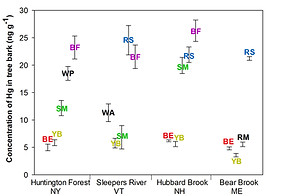
Selected Leading Projects
2021 - 2023
We are investigating the linkages between depth-dependent microbial structure, function, and biotic and abiotic features of the soil environment.


2019 - 2020
A Synthesis of Water and Nutrient Dynamics at the Southern Sierra Nevada in California
We synthesized the existing measurements of net ecosystem carbon exchange, atmospheric deposition of nitrogen and phosphorus, nutrient stocks in tree biomass and soils, and nutrient fluxes in snowmelt, soil solution, streamflow, and sediments to ask:
1. How does climate warming impact biogeochemical cycles of carbon, nitrogen, and phosphorus using space-for-time substitution?
2. How does a major drought event (2013-2016) alter water quality and hydrologic nutrient fluxes?
3. How does management practice (i.e., forest thinning) alter water quality and hydrologic nutrient fluxes?


2018 - 2019
We analyzed the spatial and temporal trends of loon mercury (Hg) in the New York’s Adirondack Park
We found a delayed recovery of Hg concentrations in loons, despite recent declines in atmospheric Hg. For monitoring Hg concentrations, more acidic lakes required greater sampling intensity than less acidic lakes.



2018
Quantifying rates of change in soil carbon and nutrients is essential to understanding the global carbon cycle as well as to guiding local management decisions. However, change in soils can be nonlinear, difficult to detect, and dependent on the depth of soil examined.
We found that, during the forest transition phase (i.e., in 1990s), tree biomass loss to mortality exceeded biomass accumulation of the remaining trees. Thus tree demand for nutrients was reduced at the same time as decomposition of woody debris and the organic horizon returned N, Ca, Mg and K to the top layers of mineral soil, leading to re-accumulation of those elements at those depths (quadratic temporal trends).
It is important to consider the pattern and rate of the expected change, and how that may vary by element and depth, when designing and evaluating soil monitoring studies.

2017 - 2018
Mercury (Hg) is a neurotoxic pollutant emitted by anthropogenic activities that can be transported long distances and deposited in remote forested areas. Soils are the largest pool of Hg on land. Pathways of Hg accumulation and loss in forest soils include throughfall, litterfall, soil gas fluxes, and leaching in soil solutions, all of which will likely be altered under changing climate.
We compared Hg inputs in throughfall and leaf litterfall and Hg outputs in soil gas fluxes and soil solution in three ongoing climate change manipulation studies at the Hubbard Brook Experimental Forest, New Hampshire, USA:
1. A combined summer-warming and winter-freezing experiment (CCASE)
2. Throughfall exclusion to mimic drought
3. A simulated ice storm experiment (ISE)
We found that our forest soils served as a net sink for Hg in our undisturbed plots and climate manipulation plots. However, climate changes such as warmer air temperatures and more intense ice storms exacerbated Hg pollution by releasing Hg sequestered in forest soils.

2015 - 2017
Mercury (Hg) in the environment has been receiving increased attention, but little is known about the Hg that accumulates in trees. The purpose of this project was to advance the understanding of Hg in forest biomass.
We analyzed Hg concentrations in foliage, bark and bole wood of eight tree species at four sites in the northeastern USA (Huntington Forest, NY; Sleepers River, VT; Hubbard Brook, NH; Bear Brook, ME).
We found sites differed significantly in Hg concentrations of foliage and bark, which are directly exposed to the atmosphere, but the concentration of Hg in wood depended more on species than site. The Hg contents of tree tissues in hardwood stands were higher in bark and wood than in foliage. In conifer stands, because foliage is retained longer and has higher Hg concentrations, the foliar pool tended to be more important.



2012 - 2014
Decisions about sampling intensity should be made with knowledge of which measurements are most variable.
We found that accurately estimating nutrient concentrations of foliage would require fewer replicate samples than for wood.
Among elements, we found that nitrogen and phosphorus exhibited the smallest variation across trees and years, and thus fewer samples would be needed to detect differences across sites or over time for these than for other elements
